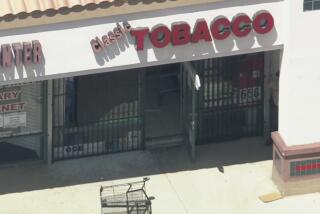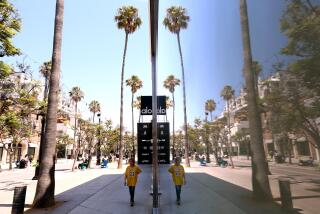On Road to Renewal : Norwalk Is Ready to Revitalize Aging Front Street Strip, a Downtown That Died
- Share via
NORWALK — A turn-of-the-century clock on a Front Street store building is a visual reminder of the small shopping strip’s plight: The clock stopped working years ago, and only one hand remains.
The buildings that surround it are in a similar state of disrepair, sitting in a neglected and forgotten corner of the city that once was Norwalk’s glory and former downtown.
But an effort first initiated seven years ago to reverse the shopping strip’s downward slide will soon be under way.
Work will begin this month to modernize the exterior of small stores that line Front Street from San Antonio Drive to Clarkdale Avenue, which served as the hub of the city until the early 1950s.
The Front Street Revitalization Project will “reorient” the string of small stores to face Firestone Boulevard, now one of the busiest streets in the city, in an attempt to attract more customers and stimulate business in the center, said Don Rouly, the city’s director of planning and development.
“We want to make the center more viable than it has been,” Rouly said, noting that the Front Street stores have inadequate parking and are not visible from Firestone. “We were thinking maybe we can do something to turn that around.”
Several buildings that fronted on Firestone and Clarkdale were bought by the city and all but one has been razed to make room for a parking lot that will be accessible from the boulevard.
Although the shopping strip is in a redevelopment area, the effort is separate from other redevelopment projects, Rouly said. Because the city was working on the project before the redevelopment plan was adopted in 1984, the improvements will be paid for with federal community block grant funds, he said.
The city will spend about $1 million for various improvements to the exteriors of the stores. Low-interest loans of up to $25,000 will also be made available to store owners who want to rehabilitate interiors.
Improvements will include underground utilities, landscaping, lattice-covered pedestrian walkways and uniform signs.
Owners Agreed Last Month
The restoration project took more than six years to come to fruition. Rouly said the on-again, off-again process took so long because the project needed the support of the store owners. Agreements between the city and owners were approved by the City Council in late June. Many of the buildings, constructed from the turn of the century to the 1940s, have not been remodeled or substantially changed since they were first built. Wong’s Market, which opened in 1941, still has the neon sign that was popular during that era. The former Bank of Norwalk--which later became a Bank of America--kept its historic but non-functioning clock and now houses a record store. Other establishments now on Front Street, in buildings that were mainly constructed of brick, include a check-cashing store, a graphics and design store and a plumbing store.
Because the buildings had “neat architectural features,” the city decided to update them rather than knock them down and start over, Rouly said.
“We’re still preserving the old and adapting it to more modern times,” he said. “It’s the original downtown area. We want to take advantage of the older, historical buildings.”
To store owner Lowell Wong, the project could herald a new beginning for his aging store.
“This is the only chance for us to keep up with time. We’re behind,” said Wong, who with his brother Jack took over the store in 1960 when his father retired.
Wong said a lack of working capital prevented him from improving his store on his own. “Look at how old the floor is,” he said, pointing to the original concrete surface. Wong said he will get a loan from the city to put in a new floor, ceiling and lights.
Frank Riggio, part owner and meat cutter who has worked at Wong’s since 1950, said he knows the area cannot be returned to the hustle and bustle that characterized it during the late 1940s and early 1950s. But he said the project is a step in the right direction.
“We knew if we would stick it out long enough, history would recycle itself. We weren’t going to give up,” said Riggio, who has lived in Norwalk for more than 30 years. He said he and Wong often discussed the demise of the Front Street center but both would agree that “one day, business will come back to this area.”
Billie Robinson, a member of Norwalk’s Historical Heritage Commission, said the street was once a center of activity because the old railroad depot was on the north side of the street.
“The railroad came through in 1874 and it just kept growing,” she said. “The depot held it together.”
Southern Pacific Railroad closed the depot in the early 1960s and tore it down by 1968, Robinson said.
“This was Norwalk,” Riggio said. The city’s former downtown once contained a J.C. Penney department store, the post office, the state Department of Motor Vehicles office and the bank.
But rapid construction during the early 1950s, which eventually brought in other grocery stores and commercial businesses, overtook the tiny strip.
The bank soon moved to Firestone Boulevard, the post office relocated to Orange Avenue and the Penney store moved to a new shopping center.
“This stopped being the center of Norwalk. The handwriting was on the wall,” Riggio said.
By 1955, the Front Street shopping strip “just went kapook,” Riggio said. Business went from $1 million to a year to its current average of $750,000, he said.
Riggio said he knew that city planners would have to focus on revitalizing existing areas of the city because most of Norwalk is developed. So he and the Wong brothers patiently waited.
“This is going to be terrific for us,” he said.
More to Read
Sign up for Essential California
The most important California stories and recommendations in your inbox every morning.
You may occasionally receive promotional content from the Los Angeles Times.






